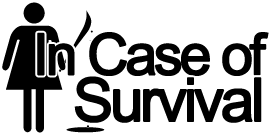In child development, the time between infancy and kindergarten is one of the most important. During this time, children learn the basics, like the alphabet and numbers. It’s also when they learn basic (but important) life skills, like how to go to the bathroom in a place other than their pants.
This won’t change after the apocalypse. Those crucial early years will remain just as crucial, though the education system will probably change.
I imagine it’d be a little tricky to send little Johnny off to school when he’s living the nomadic survivor lifestyle with the rest of his survivor group (or survivor band, or survivor tribe, or whatever you want to call it—personally, I like tribe).
Education is going to be up to the tribe. This means, of course, that someone in the tribe is going to be in charge of teaching the next generation how to survive and stay alive—and it might be you. Post-apocalyptic Earth is going to be the living definition of survival of the fittest. If you want your tribe (and your children) to survive, you’re going to have to teach them how to do it. But, while survival skills are important, you can’t forget the basics. Knowing the alphabet and how to count will still be important. Learning how to not poop one’s pants is going to be vital because where, exactly, are you going to get your diapers?
Since the tribe itself is going to be the school, you’re going to have to develop your own curriculum. A good curriculum starts from the ground up, with each year building on the year before. This means that your curriculum is going to start at the toddler/preschool level, because that’s the first rung of educational ladder. At this level, kids are still learning the alphabet, numbers, colors and shapes, and animals.
To help you get started, here is a basic curriculum guide for your survival-based tribal preschool:
Colors and shapes
Instead of posters or flash cards, use the instrument panels of electronic devices (assuming that any technology that survives the apocalypse is in any sort of working order). The various buttons, icons, and displays can serve as good teaching tools in this case. If there aren’t any electronic devices in your possession, then maybe use survival gear (for example, “The front of our tent is a brown triangle,” or something similar). You can also use the ruins of buildings or geologic structures.
Alphabet
This is very important, as it leads to reading and writing. Use whatever you can to teach the alphabet, such as labels on any equipment you may have, or warning messages from ally tribes. Use those same labels and messages to teach word recognition, then eventually phonics and reading, followed by writing. Reading and writing are going to be quite useful, I suspect, especially if your survivor tribe allies with other tribes. If you can’t read that warning message from one of your allies about the approaching alien battle-robot army, then it’s most certainly going to be your fault when your tribe gets assimilated.
Numbers
Don’t forget about teaching numbers (and counting). After all, you’re going to need to know how to count how many alien battle-robots make up that army. If you have any maps lying around, maybe number the sections. That way, you can teach survival skills and numbers at the same time. For example, a lesson could be teaching the children to go to Section 4 in the event of a zombie attack. If you show them the numbered Section 4 on the map of your camp, they’ll become familiar with the number. They’ll also know where to go in case those pesky zombies ever come knocking. If you do this, I suggest you also number the real-life Section 4; you can point it out to them anytime you walk by. While I suspect that the kids will just follow the screaming horde of people if zombies ever come into your camp, it never hurts to be prepared.
Animals
Instead of teaching animals, teach bad guy recognition. Knowing what a cat looks like isn’t going to be as important as knowing what a mutant bee looks like, if that mutant bee is going to impale you with its stinger before using you to pollinate a tree. It’s very important for children to be able to identify bad guys on sight, and preferably from a distance.
If you have any artists in your tribe, maybe get them to make drawings of all the bad guys, monsters, and/or aliens populating your post-apocalyptic world.
You can, of course, take pictures of them, if you like to live dangerously like that.
This is just a general overview.
Obviously, the day to day lesson planning is going to fall to you, but these basic ideas and themes may help.
Don’t bother with formal lesson plans—paper is probably going to be hard to find, and they’re just going to be more things to pack if you need to leave in a hurry.
Keep in mind that the toddler and preschool years are also when children learn how to dress themselves, how to talk/yell (which would be very good in terms of warning you about approaching bad guys), and, of course, how to go to the bathroom in a bathroom. But you’re going to have to develop your own curriculum for that.
